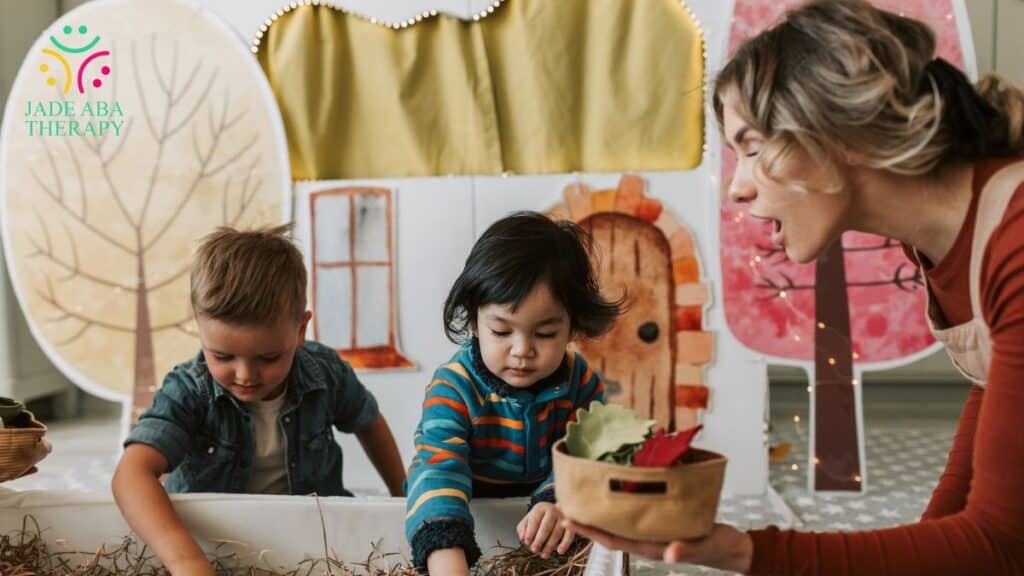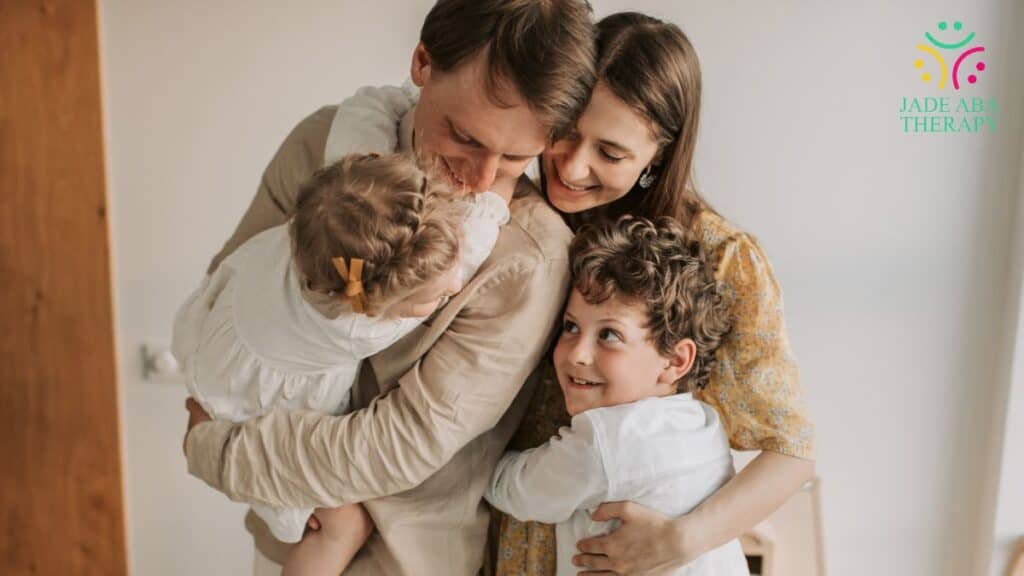Key Points:
- ABA helps children thrive when parents join sessions, track progress, and apply strategies at home.
- In-home ABA in Virginia and Maryland builds skills in real settings.
- BCBAs guide plans, therapists teach routines, and families use clear data and coaching to support steady daily progress.
Parents usually see ABA terms, targets, and acronyms before they see real-life change. ABA can feel like it is happening in a notebook instead of in the kitchen or on the playground. A parent’s guide should explain how to talk to the BCBA, what 30-day progress really looks like, and how to read the data that comes home.
The goal is simple: use ABA therapy tips for parents so daily life in your home starts to feel easier for your child.

Parent’s Guide to ABA: What Are We Trying to Do?
ABA in this context is not a definition lesson. ABA here is a plan for helping a child with autism use skills in normal routines. The BCBA designs it, the technician runs it, and the family keeps it alive between visits.
Parent goals often include:
- Make skills usable. Teach the child to answer, ask, or follow in places where you actually need it.
- Make progress visible. See small wins in 30 days so you know sessions are working.
- Make family participation normal. Join sessions, repeat the prompts, and report back.
A recent AAP report notes that children should have access to at least 25 hours per week of planned intervention to work on social communication and behavior, which is why home practice matters so much.
Autism therapy parent support and ABA parent training goals should be active. Parents ask, watch, and copy. That is how ABA strategies for children turn into family routines rather than one-on-one drills.
What Should You Ask Your BCBA?
A good parent’s guide to ABA always starts with the right questions. These questions keep the team honest and the program practical.
Ask these in the intake or first parent meeting:
- “What are the top 3 behaviors or skills you will work on first?” You want targets tied to safety, communication, or daily living.
- “How will sessions look inside our home?” Clarify what happens in the living room, kitchen, bedroom, and backyard using an in-home ABA setup checklist.
- “What is my role every week?” Ask how often you should model, record, or join.
- “How will you teach generalization?” Skills should show up with siblings, grandparents, and in the car.
- “When will I see updated data?” Weekly or biweekly is reasonable for most home programs.
Short list of follow-ups:
- Clarify replacement behaviors. Ask what the child should do instead of the problem behavior.
- Clarify reinforcement. Ask what reward will be used and if it is parent-friendly.
- Clarify crisis steps. Ask what to do if a behavior escalates and no therapist is present.
Parent questions like these keep the BCBA focused on what you actually see at home, and they line up well with caregiver training in ABA that teaches parents how to repeat the plan.
What Should Progress Look Like After 30 Days?
ABA progress in 30 days is early, so expect momentum but not total change. Early gains often appear in cooperation, transitions, and simple communication.
Reasonable 30-day signs:
- More responding. Child follows simple directions from therapist and sometimes from the parent.
- Fewer long meltdowns. Duration or intensity starts to go down because the plan is consistent and follows ABA therapy for challenging behaviors.
- More successful practice. Child can do a small skill in more than one room or with one more person.
Studies on early intensive behavioral intervention show that when treatment is delivered often and parents help, skills improve across several areas over the first months and keep growing over 12–24 months.
Progress check ideas for parents:
- Ask for a 30-day mini-report. It can be 1 page.
- Compare baseline to now. Were there 6 tantrums a day before and now 3?
- Confirm parent training. You should have been taught at least 1 skill to run alone.
Helping a child with autism is easier when 30-day wins are visible. Small wins show that the plan is right and that home practice is working.

What Data Should Families Receive Regularly?
ABA lives in data. Parents should see it, read it, and question it.
Data collection in ABA therapy you can request:
- Frequency data. How many times did the behavior happen.
- Duration data. How long the behavior lasted.
- Skill-acquisition data. How many correct responses out of total trials.
- Parent-training log. How many times the BCBA coached you.
Ask the BCBA to explain:
- Trends. Are we going up, down, or staying flat.
- Context. Did school days or illness affect the numbers.
- Next step. What will be adjusted based on this week.
Parent-mediated autism programs delivered in homes or remotely have shown that when parents are trained and can follow through, social and communication skills improve.
Data reviews should be short. Ten minutes at the end of a session or a weekly call is enough. Autism therapy parent support is stronger when the family can quote the numbers back to the team.
How Does Family Participation Keep Skills Going?
ABA strategies for children work faster when everyone in the home uses the same wording and reward system.
Ways families participate:
- Join 1 session a week. Watch the prompts and copy them.
- Run 5-minute practices. Do one request, one play skill, or one self-help routine.
- Report big changes. Tell the BCBA if school or therapy in another clinic is working on the same target.
Research on parent-mediated interventions shows that parent involvement predicts better outcomes across skills because the child receives more learning trials in natural routines.
ABA therapy tips for parents usually sound simple, but repetition matters more than the cleverness of the strategy. The more you run the steps, the easier it is for your child to respond to you.

How This Works in Virginia and Maryland Homes
Virginia and Maryland both recognize ABA for children with autism, and many plans now include it when it is medically necessary.
- Virginia: State law requires coverage for diagnosis and treatment of autism, including ABA, for children of any age, with some benefit limits. This makes home-based programs more realistic for families who qualify.
- Maryland: Medicaid and state-regulated plans cover ABA for members under 21 when it is medically necessary, and services can be delivered at home or in the community.
What this means for a home program:
- BCBA still does the assessment. A licensed or approved professional documents the need.
- Technicians can come to the home. Sessions can run in living rooms, kitchens, or apartments, which is important for young children.
- Parents can be trained on-site. Coaches can show you how to manage mealtime, bath time, and homework in your own setup.
Mention your insurance type early in the process so the BCBA can plan a program that fits Virginia or Maryland rules.
Frequently Asked Questions
How much ABA is enough for my child?
ABA intensity for children with autism typically ranges from 25 to 40 hours per week when targeting broad early developmental goals. Lighter plans of 10 to 15 hours per week can support progress if parents consistently practice skills at home and the focus remains narrow.
Can I ask the BCBA to change goals if they do not match home priorities?
Parents can ask the BCBA to change goals if they do not match home priorities. Medical necessity often includes parent input, especially when behaviors affect daily living. If a skill lacks relevance or takes too long to teach, the BCBA can replace it with a safer, more functional alternative.
What if I do not get regular data from the team?
Parents who do not receive regular ABA data should request a standard report with targets, trial dates, trial counts, and success rates. Reports can be shared by email or during parent training. Missing data should be followed up with a request for the update timeline to monitor progress.
Start ABA Support for Your Family Today
Helping a child with autism thrive starts with a clear parent role, steady 30-day check-ins, and data you can actually read. In-home ABA therapy in Maryland and Virginia makes this practical because coaching happens where behavior happens.
At Jade ABA Therapy, we partner with caregivers so BCBA plans, technician sessions, and family routines are all moving in the same direction. If your child needs a parent-friendly program that teaches you what to ask, what to expect, and how to keep skills going, reach out to learn how our team can set up services in your area.




